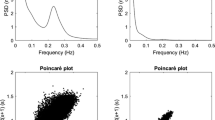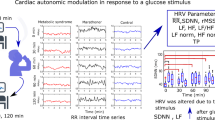Abstract
Background
It is unknown whether gastric myoelectrical activity (GMA) and autonomic functions are altered in obesity. The aims of this study were to investigate GMA and autonomic functions in obese subjects and to compare their responses to different meals with lean subjects.
Methods
The study was performed in 12 lean and 12 obese subjects. GMA was measured using electrogastrography, and autonomic functions were assessed using spectral analysis of heart rate variability.
Results
The study achieved the following key results: (1) Compared to lean subjects, obese subjects showed unaltered gastric slow waves at baseline but enhanced responses to both fatty and protein meals. The lean subjects showed a reduced percentage of normal gastric slow waves with a fatty meal, which was not seen in obese subjects; lean subjects showed no changes in the dominant frequency or power of the gastric slow waves with a protein meal, whereas both of these parameters were increased in obese subjects. (2) Autonomic functions were altered in obese subjects in both fasting and fed states. Obese subjects showed an increased sympathetic activity in the fasting state, but absence of a normal postprandial response in sympathovagal balance to both fatty and protein meals.
Conclusions
The findings on gastric slow waves demonstrate that obese subjects are more receptive to fatty meals and more responsive to protein meals. Obese subjects have impaired autonomic functions in both fasting and fed states. The alterations in gastric and autonomic functions may contribute to eating disorders in the obese.




Similar content being viewed by others
References
Chen JDZ, McCallum RW. Electrogastrographic parameters and their clinical significance. In: Chen JDZ, McCallum RW, editors. Electrogastrography: principles and clinical applications. New York: Raven; 1994. p. 45–73.
Chen JDZ, Schirmer BD, McCallum RW. Serosal and cutaneous recordings of gastric myoelectrical activity in patients with gastroparesis. Am J Physiol. 1994;266:G90–8.
Parkman HP, Hasler WL, Barnett JL, American Motility Society Clinical GI Motility Testing Task Force, et al. Electrogastrography: a document prepared by the gastric section of the American Motility Society Clinical GI Motility Testing Task Force. Neurogastroenterol Motil. 2003;15:89–102.
Koch KL, Hong SP, Xu L. Reproducibility of gastric myoelectrical activity and the water load test in patients with dysmotility-like dyspepsia symptoms and in control subjects. J Clin Gastroenterol. 2000;31:125–9.
Coleski R, Gonlachanvit S, Owyang C, et al. Selective reversal of hyperglycemia-evoked gastric myoelectric dysrhythmias by nitrergic stimulation in healthy humans. J Pharmacol Exp Ther. 2005;312:103–11.
Sha W, Pasricha PJ, Chen JD. Rhythmic and spatial abnormalities of gastric slow waves in patients with functional dyspepsia. J Clin Gastroenterol. 2009;43:123–9.
Moukarzel AA, Sabri MT. Effect of gastric myoelectric activity on carbohydrate absorption of fruit juice in children. J Clin Gastroenterol. 2000;30:162–9.
Lin X, Chen JZ. Abnormal gastric slow waves in patients with functional dyspepsia assessed by multichannel electrogastrography. Am J Physiol Gastrointest Liver Physiol. 2001;280:G1370–5.
Riezzo G, Chiloiro M, Guerra V. Electrogastrography in healthy children: evaluation of normal values, influence of age, gender, and obesity. Dig Dis Sci. 1998;43:1646–51.
Chen J, McCallum RW. Effect of milk on myoelectrical activity in normal human stomach—an electrogastrographic study. Med Biol Eng Comptrol. 1992;30:564–7.
Chen J, Davenport K, McCallum RW. Effect of fat preload on gastric myoelectrical activity in normal humans. J Gastrointest Mot. 1993;5:281–7.
van Dielen FM, de Cock AF, Daams F, et al. Gastric myoelectrical activity in morbidly obese patients before and 3 months after gastric restrictive surgery. Obes Surg. 2003;13:721–7.
Riezzo G, Pezzolla F, Giorgio I. Effects of age and obesity on fasting gastric electrical activity in man: a cutaneous electrogastrographic study. Digestion. 1991;50:176–81.
Tougas G, Spaziani R, Hollerbach S, et al. Cardiac autonomic function and esophageal acid sensitivity in patients with non-cardiac chest pain. Gu. 2001;49:706–12.
Muth ER, Koch KL, Stern RM. Significance of autonomic nervous system activity in functional dyspepsia. Dig Dis Sci. 2000;45:854–63.
Matsumoto T, Miyawaki C, Ue H, et al. Effects of capsaicin-containing yellow curry sauce on sympathetic nervous system activity and diet-induced thermogenesis in lean and obese young women. J Nutr Sci Vitaminol (Tokyo). 2000;46:309–15.
Tentolouris N, Tsigos C, Perea D, et al. Differential effects of high-fat and high-carbohydrate isoenergetic meals on cardiac autonomic nervous system activity in lean and obese women. Metabolism. 2003;52:1426–32.
Nagai N, Sakane N, Hamada T, et al. The effect of a high-carbohydrate meal on postprandial thermogenesis and sympathetic nervous system activity in boys with a recent onset of obesity. Metabolism. 2005;54:430–8.
Chen DD, Xu X, Zhao Q, et al. Effects of audio stimulation on gastric myoelectrical activity and sympathovagal balance in healthy adolescents and adults. J Gastroenterol Hepatol. 2008;23:141–9.
Chen JDZ, McCallum RW. Clinical applications of electrogastrography. Am J Gastroenterol. 1993;88:1324–36.
Wang ZS, Robust CJDZ, ECG RR. Wave detection using evolutionary-programming-based fuzzy inference system (EPFIS), and application to assessing brain-gut interaction. IEE Proc-Sci Meas Techno. 2000;147:351–6.
Berntson GG, Bigger JT, Eckberg DL, et al. Heart rate variability: origins, methods, and interpretive caveats. Psychophysiology. 1997;34:623–48.
Markad VK, Fallen EL. Power spectral analysis of heart rate variability: a noninvasive signature of cardiac autonomic function. Crit Rev Biomed Engl. 1993;21:245–311.
Chen JDZ, Lin ZY, McCallum RW. Abnormal gastric myoelectrical activity and delayed gastric emptying in patients with symptoms suggestive of gastroparesis. Dig Dis Sci. 1996;41:1538–45.
Tonhajzerova I, Javorka M, Trunkvalterova Z, et al. Cardio-respiratory interaction and autonomic dysfunction in obesity. J Physiol Pharmacol. 2008;59:709–18.
Piestrzeniewicz K, Łuczak K, Lelonek M, et al. Obesity and heart rate variability in men with myocardial infarction. Cardiol J. 2008;15:43–9.
Kaufman CL, Kaiser DR, Steinberger J, et al. Relationships of cardiac autonomic function with metabolic abnormalities in childhood obesity. Obesity. 2007;15:1164–71.
Rabbia F, Silke B, Conterno A, et al. Assessment of cardiac autonomic modulation during adolescent obesity. Obes Res. 2003;11:541–8.
Karason K, Mølgaard H, Wikstrand J, et al. Heart rate variability in obesity and the effect of weight loss. Am J Cardiol. 1999;15(83):1242–7.
Hirsch J, Leibel RL, Mackintosh R, et al. Heart rate variability as a measure of autonomic function during weight change in humans. Am J Physiol. 1991;261:R1418–23.
Antelmi I, de Paula RS, Shinzato AR, et al. Influence of age, gender, body mass index, and functional capacity on heart rate variability in a cohort of subjects without heart disease. Am J Cardiol. 2004;93:381–5.
Matsumoto T, Miyawaki T, Ue H, et al. Autonomic responsiveness to acute cold exposure in obese and non-obese young women. Int J Obes Relat Metab Disord. 1999;23:793–800.
Conflict of Interest
All of the authors, Xiaohong Xu, Dennis Chen, Jieyun Yin, and Jiande Chen, declared no conflict of interest.
Author information
Authors and Affiliations
Corresponding author
Rights and permissions
About this article
Cite this article
Xu, X., Chen, D.D., Yin, J. et al. Altered Postprandial Responses in Gastric Myoelectrical Activity and Cardiac Autonomic Functions in Healthy Obese Subjects. OBES SURG 24, 554–560 (2014). https://doi.org/10.1007/s11695-013-1109-6
Published:
Issue Date:
DOI: https://doi.org/10.1007/s11695-013-1109-6




